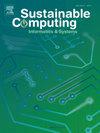Efficient QCA‐Based Circuits for Low‐Power Medical IoT System
IF 5.7
3区 计算机科学
Q1 COMPUTER SCIENCE, HARDWARE & ARCHITECTURE
引用次数: 0
Abstract
The Internet of Things (IoT) plays a vital role in the recent healthcare industry by providing precise diagnostic and treatment capabilities. There is a growing interest in medical IoT incorporated into healthcare systems. The processing unit of all medical IoT comprises complementary metal-oxide semiconductor (CMOS) technology. However, CMOS Medical IoT technology has become integrated into biomedical hardware systems at the nanoscale regime. Due to regulatory, ethical, and technological challenges, including slow processing speeds, high power consumption, and slow switching frequencies, particularly in the gigahertz (GHz) range. On the other hand, compared to traditional computers, quantum technology will accelerate processing by an order of magnitude and affect all artificial and medical (AI) and medical IoT processing applications. Quantum-dot cellular automata (QCA) present a promising alternative digital hardware system in medical IoT. QCA technology makes an optimal choice for establishing circuit design frameworks for AI in medical IoT applications, where low-cost, real-time, energy-efficient performance is crucial. Moreever, encryption and decryption circuits have been used in medical IoT operations to protect sensitive patient data while it is being transmitted and stored. The essential arithmetic and logic unit (ALU) is proposed in this context, which is the foundation for processing and computational units for medical IoT systems at the nanoscale devices. A systematic approach is involved in integrating adders, multiplexers, an ALU, and a logic unit to enhance processor drive and privacy via encryption and decryption in medical IoT. The experimental outcomes reveal that the recommended design overtakes the previous design by 15.48 % in terms of cells and 16.07 % in terms of area. The designs are accurately simulated using the QCADesigner-E 2.0.3 software tool.
用于低功耗医疗物联网系统的高效QCA电路
物联网(IoT)通过提供精确的诊断和治疗功能,在最近的医疗保健行业中发挥着至关重要的作用。人们对将医疗物联网纳入医疗保健系统的兴趣越来越大。所有医疗物联网的处理单元均采用互补金属氧化物半导体(CMOS)技术。然而,CMOS医疗物联网技术已经集成到纳米级生物医学硬件系统中。由于监管、道德和技术方面的挑战,包括处理速度慢、功耗高、开关频率慢,特别是在千兆赫(GHz)范围内。另一方面,与传统计算机相比,量子技术将使处理速度加快一个数量级,并影响所有人工和医疗(AI)以及医疗物联网处理应用。量子点元胞自动机(QCA)在医疗物联网中是一种很有前途的数字硬件系统。QCA技术为在医疗物联网应用中建立人工智能电路设计框架提供了最佳选择,在医疗物联网应用中,低成本、实时、节能性能至关重要。此外,加密和解密电路已用于医疗物联网操作,以保护正在传输和存储的敏感患者数据。在此背景下提出了基本算术和逻辑单元(ALU),它是纳米级设备医疗物联网系统处理和计算单元的基础。系统的方法涉及集成加法器、多路复用器、ALU和逻辑单元,以通过医疗物联网中的加密和解密增强处理器驱动和隐私。实验结果表明,推荐的设计在单元数上超过了15.48 %,在面积上超过了16.07 %。利用qcaddesigner - e2.0.3软件工具对设计进行了精确仿真。
本文章由计算机程序翻译,如有差异,请以英文原文为准。
求助全文
约1分钟内获得全文
求助全文
来源期刊

Sustainable Computing-Informatics & Systems
COMPUTER SCIENCE, HARDWARE & ARCHITECTUREC-COMPUTER SCIENCE, INFORMATION SYSTEMS
CiteScore
10.70
自引率
4.40%
发文量
142
期刊介绍:
Sustainable computing is a rapidly expanding research area spanning the fields of computer science and engineering, electrical engineering as well as other engineering disciplines. The aim of Sustainable Computing: Informatics and Systems (SUSCOM) is to publish the myriad research findings related to energy-aware and thermal-aware management of computing resource. Equally important is a spectrum of related research issues such as applications of computing that can have ecological and societal impacts. SUSCOM publishes original and timely research papers and survey articles in current areas of power, energy, temperature, and environment related research areas of current importance to readers. SUSCOM has an editorial board comprising prominent researchers from around the world and selects competitively evaluated peer-reviewed papers.
 求助内容:
求助内容: 应助结果提醒方式:
应助结果提醒方式:


